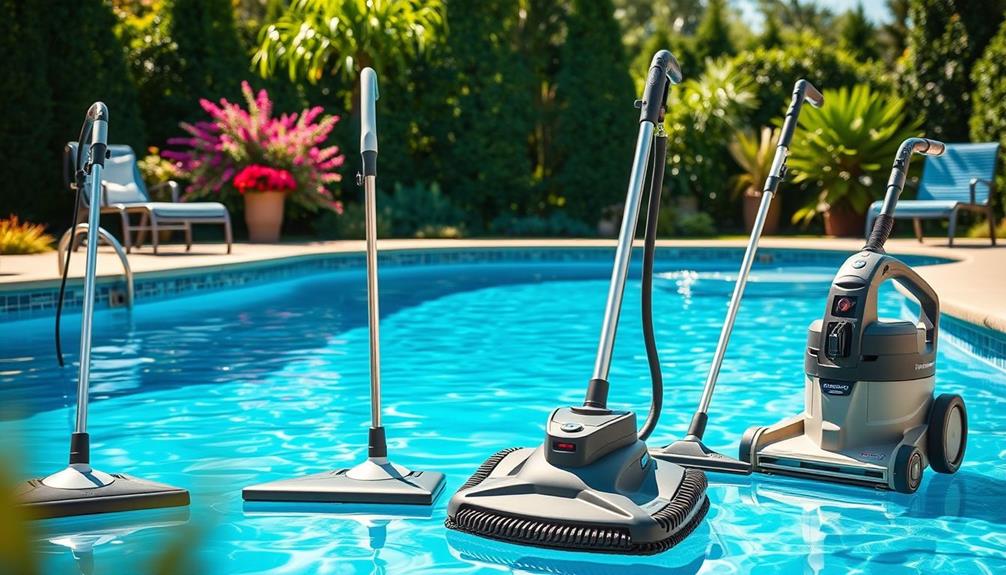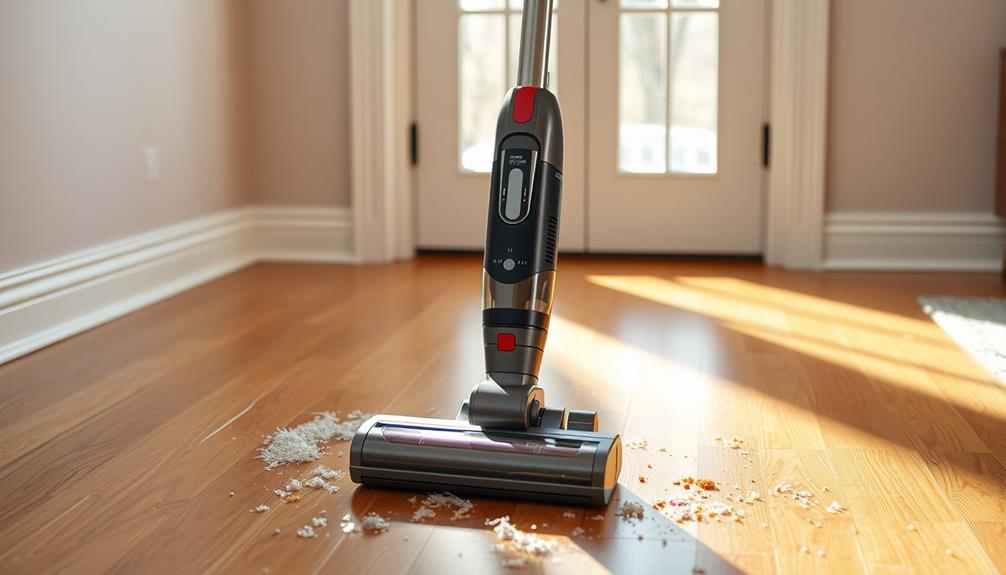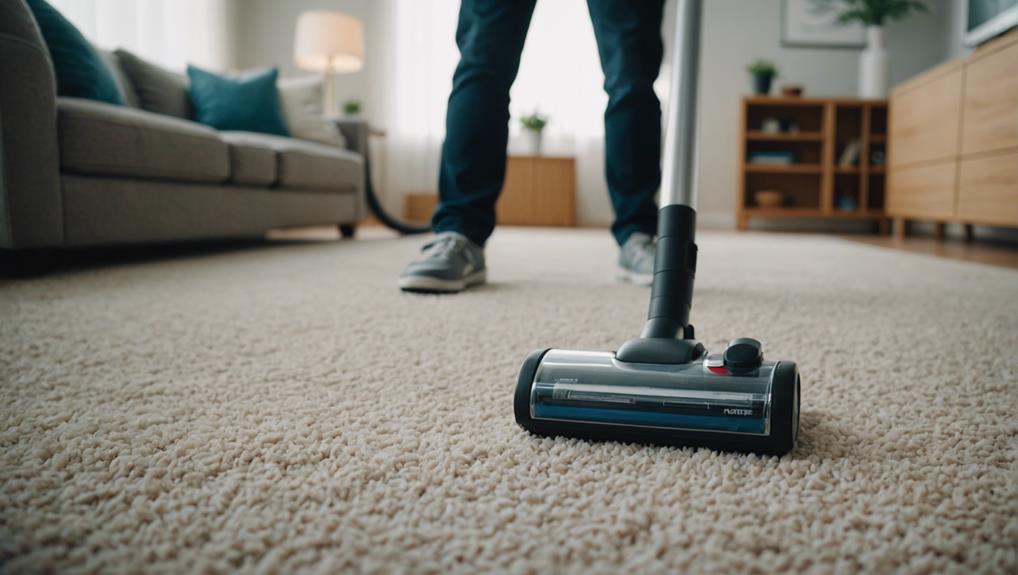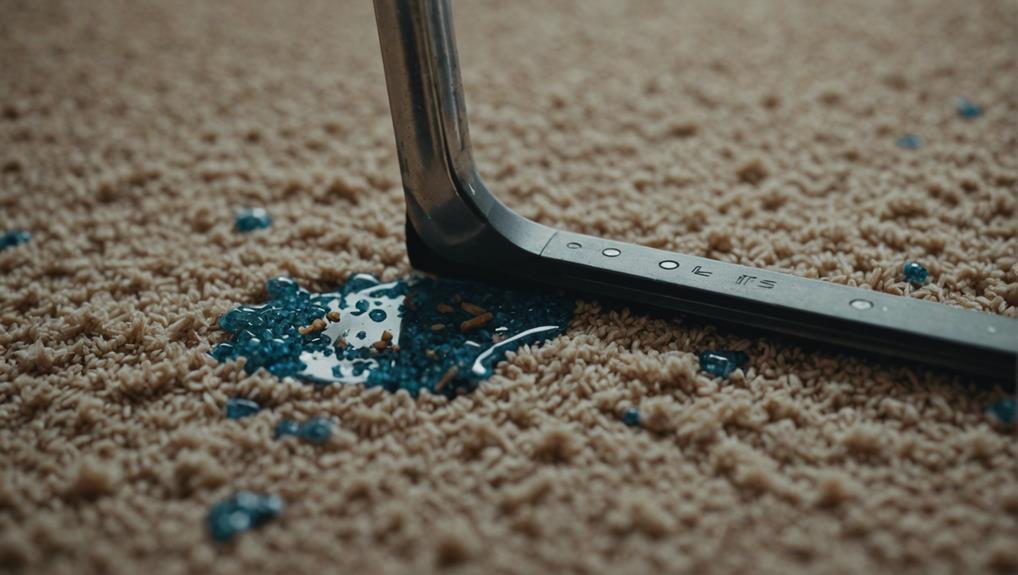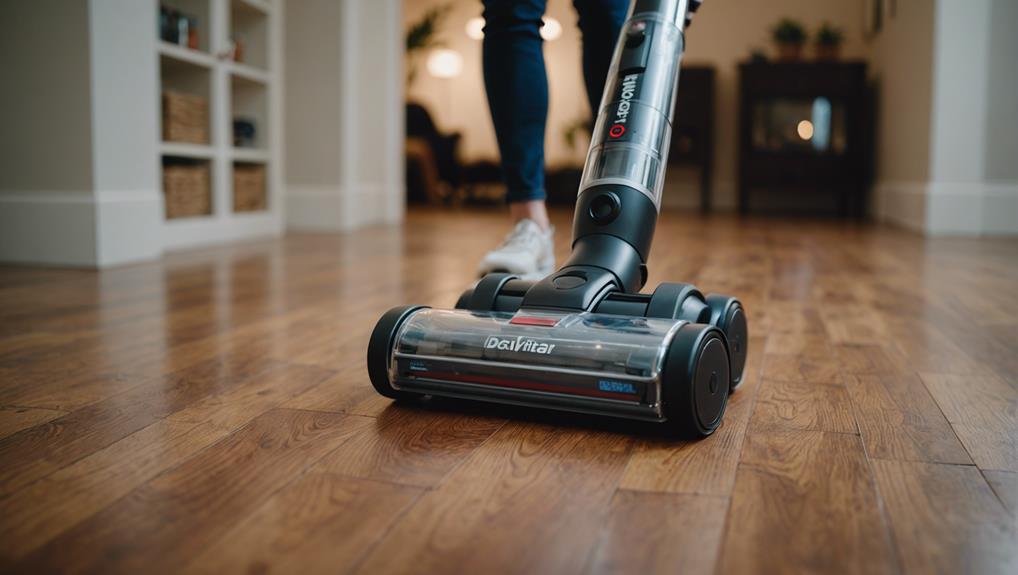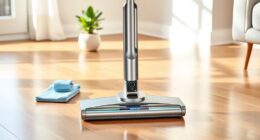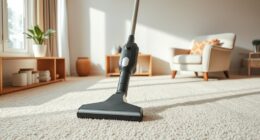In order to effectively maintain your vinyl pool, choosing the right vacuum is crucial. It is important to select models with non-abrasive brushes to safeguard your pool liner. Consider investing in a robotic vacuum for advanced suction and navigation, ensuring compatibility with your filtration system. Evaluate the suction power and energy efficiency, and opt for lightweight designs for easy handling. Regularly inspect cleaners for clogs and replace worn brushes to uphold performance. With the appropriate choice, your pool will remain clean and inviting. If you are interested in specific models or maintenance tips, you can learn more about improving your pool care routine. When choosing the right pool cleaner, it is essential to take into account the size and shape of your vinyl pool. Certain models are better suited for smaller, simpler designs, while others can handle larger, more complex layouts. Additionally, look for features such as programmable cleaning schedules and remote control options for added convenience. By taking the time to select the appropriate pool cleaner for your specific needs, you will be able to maintain a beautiful, sparkling pool throughout the season.
Key Takeaways
- Choose a vacuum with non-abrasive brushes to protect your vinyl pool liner from scratches and damage during cleaning.
- Opt for robotic vacuums for advanced navigation and powerful suction, suited for various vinyl pool shapes and sizes.
- Ensure compatibility with your pool's filtration system to maintain optimal water clarity and hygiene while cleaning.
- Look for adjustable suction power to customize cleaning intensity based on specific debris types and pool conditions.
- Prioritize energy-efficient and lightweight models for easy maneuverability and convenient storage after use.
Understanding Pool Vacuums
When it comes to keeping your vinyl pool sparkling clean, understanding pool vacuums is key. A pool vacuum automates the cleaning process by sucking up water and debris, filtering it, and returning clean water, which is essential for maintaining pool hygiene.
There are several types of pool vacuums available, including suction-side, pressure-side, robotic, and manual cleaners. Each type is suited for different pool sizes and debris types, so selecting the right vacuum is critical for efficient cleaning. For instance, some vacuums are designed with specialized features to protect delicate surfaces, similar to how vacuums for luxury vinyl plank (LVP) floors are designed to prevent scratches.
The effectiveness of a pool vacuum depends on factors like its suction power, energy efficiency, and compatibility with your pool's filter system. Regular maintenance of your pool vacuum is essential; checking for clogs and inspecting brush heads guarantees peak performance and longevity.
Since you have a vinyl pool, consider the vacuum type, ease of use, and specific cleaning needs of your pool surface when making your choice. By understanding these factors, you can ascertain that you select the right vacuum to keep your pool free from debris and looking pristine.
This proactive approach won't only enhance your pool's appearance but also prolong its life.
Importance of Pool Vacuums
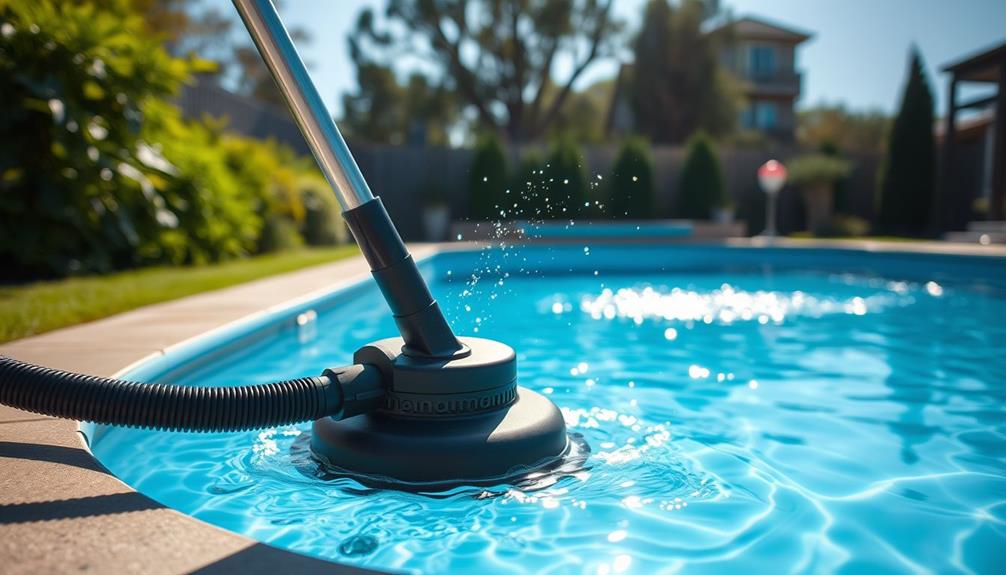
Pool vacuums are essential for maintaining a clean and safe swimming environment. A reliable pool vacuum cleaner is critical for guaranteeing water clarity, as it efficiently removes dirt and debris, both visible and microscopic.
By incorporating regular cleaning into your pool maintenance routine, you not only enhance the aesthetic appeal of your pool but also create an inviting space for leisure activities and social gatherings. Additionally, utilizing advanced robotic pool cleaners can greatly improve cleaning efficiency, allowing for more thorough and automated maintenance.
Moreover, pool vacuums play an important role in algae prevention. By disrupting the nutrient supplies that foster algae growth, these vacuums help maintain overall pool health.
When you regularly use a pool vacuum, you reduce the strain on your filtration system, which can extend the life of your pool equipment and minimize maintenance costs.
To maximize cleaning capabilities, it's important to choose the right vacuum for your specific needs. Factors like pool size, surface materials, and debris levels can affect the efficiency of your cleaning efforts.
How to Choose a Vacuum
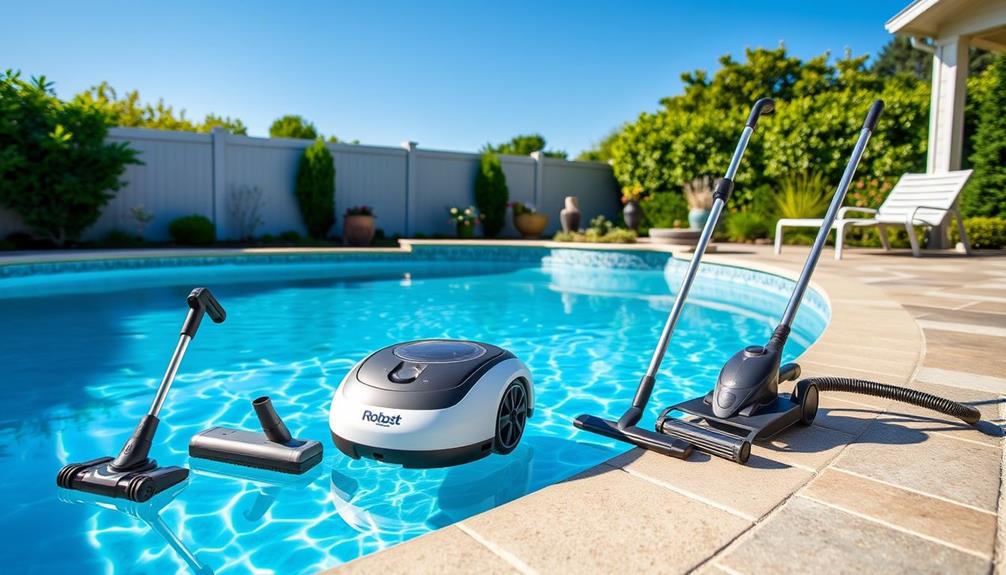
Choosing the right vacuum for your vinyl pool can greatly enhance your cleaning routine. Start by prioritizing models with non-abrasive brushes to protect your pool liner while guaranteeing thorough cleaning.
Robotic vacuums are an excellent option, as they offer advanced navigation and powerful suction capabilities, making them ideal for various pool shapes and sizes. Additionally, maintaining a clean environment around your pool can help improve the efficiency of your vacuum, much like how air purifiers reduce allergens in indoor spaces.
Next, evaluate the vacuum's compatibility with your pool's filtration system. A seamless integration guarantees peak water clarity and hygiene. Look for vacuums featuring adjustable suction power, allowing you to customize the cleaning intensity based on your pool's needs.
Additionally, energy efficiency is vital; choose models designed to minimize electricity use while maximizing effectiveness.
Don't forget to reflect on the weight and ease of use. Lightweight models make maneuverability and storage easier, especially for regular maintenance tasks.
Ultimately, the right vacuum not only streamlines your cleaning process but also helps maintain the overall health of your vinyl pool. By focusing on these key features, you can select a vacuum that meets your specific requirements and keeps your pool sparkling clean.
Enhulk Cordless Pool Vacuum
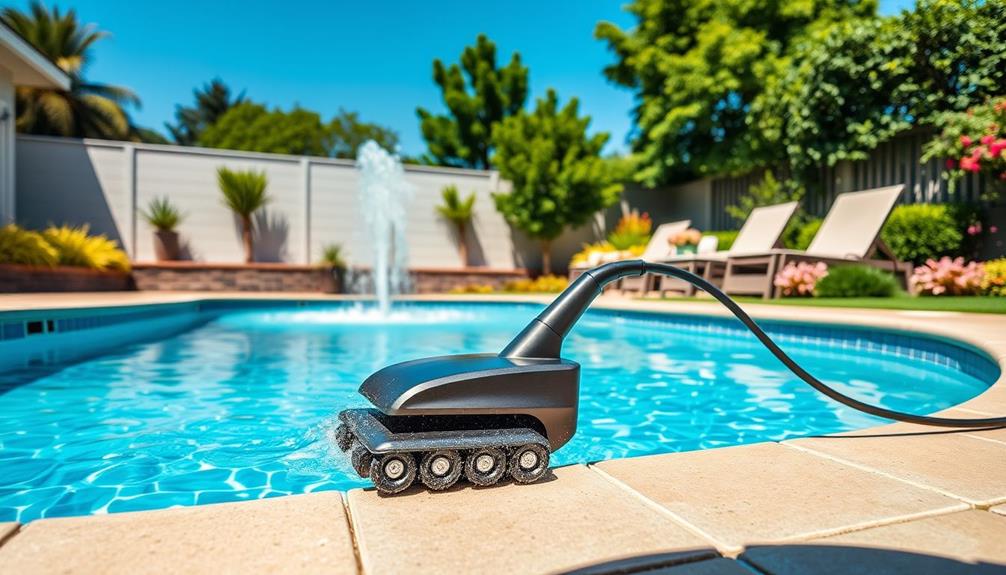
The Enhulk Cordless Pool Vacuum stands out as a powerful cleaning solution for your vinyl pool, boasting an impressive suction capacity of 15.8 gallons per minute. This cordless pool vacuum makes pool maintenance a breeze, guaranteeing you can effectively tackle dirt and debris.
Its powerful suction is complemented by two versatile brush heads designed specifically for reaching those hard-to-clean areas, assuring a thorough cleaning experience. Additionally, when selecting a cleaning device, it's important to assess service offerings to match specific cleaning needs, such as those detailed in what to look for in a home cleaning service.
One of the vacuum's standout features is its telescopic pole, which extends from 3 to 7.3 feet. This allows you to adjust the length according to your pool's depth and size for ideal reach. You'll appreciate the flexibility it provides, making it easier to clean every inch of your vinyl pool.
Powered by five 2000mAh rechargeable lithium batteries, the Enhulk offers up to 60 minutes of uninterrupted cleaning time. Plus, it only takes 1.5 hours to fully recharge.
To maximize the best battery life and maintain the vacuum's performance, regular charging every two months is recommended. With the Enhulk Cordless Pool Vacuum, keeping your vinyl pool clean has never been simpler or more efficient.
Maintenance and Troubleshooting Tips

Keeping your vinyl pool vacuum in top shape is essential for ensuring it operates effectively and efficiently. Start by regularly inspecting the suction head and hoses for clogs and debris. This maintenance tip will help maintain ideal suction performance and enhance your cleaning efficiency.
Additionally, consider using specialized tools for effective hair removal, similar to the way the Bissell Pet Hair Eraser Vacuum utilizes its self-cleaning brush roll technology to reduce maintenance effort. Also, check the brush heads for wear; worn brushes can greatly reduce your vacuum's effectiveness on vinyl surfaces, so replace them as necessary.
Don't forget about the filter bag! Clean or replace it regularly to prevent dirty or full bags from leading to inefficient cleaning and reduced suction power. After each use, charge the vacuum's batteries to guarantee maximum runtime and prevent battery damage. It's also a good practice to charge them every two months.
Lastly, store your pool vacuum in a shaded, dry area to prevent sun damage to its components. By following these maintenance tips, you can extend the life of your pool vacuum, ensuring it stays ready to tackle debris whenever you need it.
With a little effort, you'll keep your vinyl pool sparkling clean and enjoy your pool season to the fullest!
Frequently Asked Questions
How to Know What Pool Vacuum to Buy?
To know what pool vacuum to buy, assess your pool's size and shape first.
Think about the type of debris you typically find—if it's fine particles, a robotic vacuum might work best.
Check that the vacuum's compatible with your filtration system and look for features like adjustable hoses and brushes that won't damage the vinyl.
What Setting Should I Vacuum My Pool On?
When you're ready to plunge into cleaning, think of your vacuum as a powerful fish swimming through the water.
Set your filtration system to "Filter" so it can gobble up debris while sending clear water back. Keep that vacuum hose submerged to guarantee it's breathing deep, avoiding air pockets that kill suction.
If you've got heavy debris, switch to "Waste." Adjust your speed based on the mess—slow for fine particles, fast for the big stuff!
How Often Should You Replace Your Pool Vacuum?
You should replace your pool vacuum every 3 to 5 years, depending on how often you use it and how well you maintain it.
If you notice a drop in suction power or cleaning effectiveness, it's time to contemplate a replacement.
Regularly check for wear and tear, especially on hoses and brush heads, as damaged parts can hinder performance.
Following the manufacturer's guidelines can help prolong your vacuum's life, but persistent issues warrant a timely replacement.
Should You Vacuum Your Pool on Backwash or Waste?
When deciding whether to vacuum your pool on backwash or waste, consider the type of debris you're dealing with.
If you have large particles or heavy algae, using the waste setting is best, as it directly removes debris without clogging the filter.
However, if you're just maintaining the pool and want to clean the filter at the same time, backwashing can be effective.
Just remember, both methods can affect your water level and chemical balance.
Conclusion
To sum it up, choosing the right vacuum for your vinyl pool can save you time and keep your pool sparkling clean. Don't cut corners—investing in a quality vacuum makes all the difference in maintenance. Whether you go for the powerful Enhance Cordless Pool Vacuum or another option, remember to stay on top of regular upkeep and troubleshooting. With the right tools in hand, you'll be swimming in clear waters and enjoying your pool all season long!
